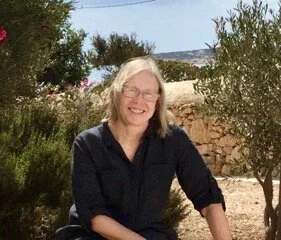Anne Myles on “Lock and Dam No. 10”
The scene portrayed in “Lock and Dam No. 10” took place several years ago. My close friend in California, who was my girlfriend over a decade ago, did visit me in Iowa, and we did spend time in the northeast Iowa river town of Guttenberg, located about an hour and a half from where I live in Waterloo. Beyond that, anything I imply here should be taken as fiction, or at least shaped for the poem’s purposes. (I confess I only learned about the Bible facsimile in the library while working on the poem, and have not yet seen it for myself.)
Though it comes from an earlier memory, this poem will always remind me of 2020, since the only traveling I did during the pandemic year was to the Upper Mississippi. Part of the Driftless Region, it’s a landscape that feels distinctively different from the more typical midwestern farmland that surrounds me, yet it’s close enough to reach without having to stop along the way. A different poem emerged last fall from two trips to the Wisconsin side, where I found the Mississippi taking on life as a personal symbol in a way it had not previously done. In that poem, I mention the river widening and pooling as it’s held back by locks and dams, an image I felt had considerable resonance in my emotional life. It was my MFA advisor who suggested that that motif might be worth exploring further in other poems. That struck me as a promising idea, but the only starting point that came to mind was the Guttenberg visit, along with the childhood memories of fishing with my parents near Chaffey’s Lock on the Rideau Canal in Ontario I layer in. The title reminds me, however, that there are other locks and dams, external or internal, I might yet discover. . . .
Everything takes a long time until what happens next, I write. This has perhaps been truest in my life regarding poetry itself. I lost my connection to poetry for about three decades as I got taken over by academia; if there’s a damming in my life I truly regret, it’s that. However, since poetry returned to me in 2018 things have in fact happened very fast; I left my academic position and am currently in my final semester of MFA work. So much of the inner part of this experience has felt like an effort to unlock, to flow down into the heartland, which also involves not hiding from patterns of loss, longing, and unfulfillment in my relational life. That too is in the poem, of course. And it connects back to the suspended waiting that many of us are experiencing during COVID-19. Something does happen next, but I don’t—we don’t—know exactly what it is.
Poems come to me with a distinct sense of rhythm, syntax, and line, usually very different in each poem—I’d say that’s what I usually encounter first, before phrases or images, and if I don’t hear a particular rhythm it’s very difficult for me to write. I didn’t know exactly what would arrive in this poem in terms of content after I placed two women on the shore overlooking the lock, but I knew I wanted the prose lines, the slow movement, the sentences with their heavy ends—the heat-drugged torpor of an August afternoon, the long wait for the lock to complete its process, what it feels like to think of something you might say and then choose not to. A rhythm of regret, perhaps, but also acceptance, because what else is there?



